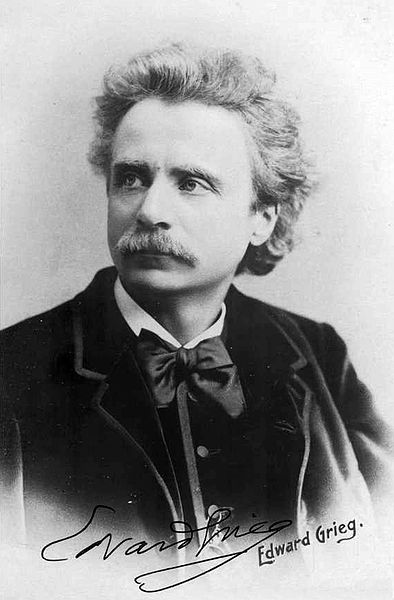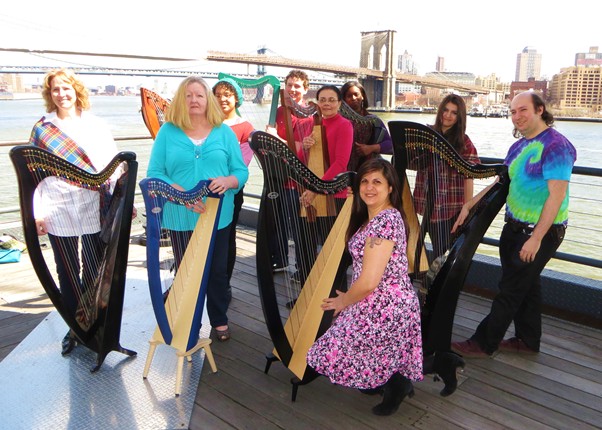The Edvard Hagerup Grieg ControversyEdvard Grieg (June 15, 1843-Sept. 4, 1907) is widely known for his music. He has been hailed as Norway’s best known composer. His works include the Piano Concerto #1 in A minor, the Per Gynt Suite, The Homberg Suite and a number of songs and piano pieces.  So what is he doing in a Scottish oriented paper? Several people have labeled Grieg a Scot, and indeed in some senses he is. The spelling of his name is odd for Norwegian, but it is also known that his great-grandfather who spelled the name Greig was a Scot from Aberdeen who had left Scotland after the 1746 Battle of Culloden and traveled to many places, finally settling in Norway and establishing business interest in Bergen on the west coast of Norway, keeping the family at least reasonably close to Scotland. Grieg’s father Alexander Grieg (1806-1875) was married to Gesine Judithe Hagerup (1814-1875), the daughter of a Norwegian solicitor and politican. Alexander himself was the child of Norwegian Maren Regine Grieg (Haslund)
Alexander Grieg = Magrgethe Elisabeth Heitmann (Heitmand)
|
John Grieg = Maren Regine Haslund
|
Alexander Grieg = Gesine Judithe Hagerup
|
Edvard Grieg
(You can work this out from a Grieg Web page.) So it is clear that Edvard Grieg is about 1/8 Scottish and 7/8 Norwegian! But it raises an interesting question about how someone is classified in terms of their ethnicity or “biological” inheritance. In the latter part of the 1900’s there was a considerable concern about the concept of “race” and being a biological based classification system which was “determined” by genetics. Many social scientists argued that concept of race was something that was just a classification system which made it cultural rather than biological. A similar situation would exist for example if one decided to classify as different races people with blue eyes in one and people with brown eyes in another. In effect this would be a social classification based likewise on a biological feature. Since there was a general move or Zeitgeist to reject biological determinism, the term “ethnicity” was introduced as something cultural (and therefore presumably not biologically determined). Similarly there was a shift from “sex” to “gender”. In most cases, there was no great shift in beliefs as the result of these changes. For example while sex implied only two possibilities: male and female; gender had more to do with sexual orientation which might number as many as 8 in different societies (Mohawk has 4 and the ancient Greek is reported to have had about 8). So while all the official government forms replaced dutifully replaced “sex” with “gender” they allowed only two choices: male or female! The more things change the more they remain the same! So the question of what Grieg is rest largely on whether you are thinking about his biological ancestry or his cultural identification. Grieg’s identity seems strongly Norwegian and when his first piano concerto was said to have been “too Norwegian” he supposedly quipped “Wait until you hear the second one!” So while Grieg may have a small percentage of Scottish “blood” his identity was certainly not Scottish. This problem raises its head quite often. For example, the famous principal chief of the upper Creek (Muscogee) towns was Alexander McGillivray, a Creek with a Scottish name. Alexander’s father was Lachlan McGillivray. His mother was Sehoy Marchand, herself the daughter of a “mixed blood” woman of the prestigious Wind Clan, and a French father Jean Baptiste Louis DeCourtel Marchand, This makes Alexander probably about 1/8 Creek – as much Creek as Grieg is Scottish. However, McGillivray’s cultural identification seems to be heavily Creek, whereas Grieg’s are heavily Norwegian. So in one case we have a person of “genetically” small Scottish ancestry who identifies heavily with his dominant ancestry (in terms of “genetics”) (Grieg) and another who is predominantly Scottish but seems culturally more connected to the more minor part of his genetic ancestry (McGillivray).  So neither “Scot” seems to identify with their Scottish ancestry as strongly as the other parts of their ancestry. Of course, if we talk about how many people are members of different groups there would a number which would be more people than actually exist! In effect we would have to count Grieg as being both Norwegian and Scottish and Alexander McGillivray in the French, Muskogee, Scottish and perhaps some other things. So the number of Scots from these two alone would be 2; the number of Norwegians would be 1; the number of French would be 1 and so on! One anthropologist pointed out that there is something in American culture called the “Famous relative” syndrome. He claimed that most Americans can’t actually identify their own second or third cousins – unless they are famous! It would appear that there is a similar process for including people in one’s ethnic group. Somehow the implication is that membership in one’s own ethnic group is where the talent came from (in Grieg’s case it is in fact his Norwegian mother’s family which is musical). There is probably nothing intrinsically wrong with making these claims until it starts to become a contest as to whose ethnic group is “better” as measured by how many famous people there are in it. In fact, if thinking Grieg and McGillivray have some connection with Scots, and this causes Scots to go look at Grieg’s music and something about the Creek Indians, then it seems a good thing. TARTAN DAY/WEEK/FORTNIGHT/MONTH KICKS OFF WITH A CELEBRATION AT SOUTH STREET SEAPORT IN MANHATTANAlthough Tartan Day is officially April 6th, March 30th was the first of the events that will occur in the coming week which will climax with the parade along 6th Avenue from W45 Street to W55. The Parade starts at 2.00pm. on Saturday, April 6th, Clan Currie Society, the organizer of the Scottish activities at the Seaport generally operates their part of the celebration on Ellis Island. Because of superstorm Sandy's impact on that island, the festivities this year were shifted to a different island - Manhattan, and specifically to South Street Seaport. The Seaport itself suffered major damage during the storm and many businesses in the vicinity remain closed to this day, but Pier 17, the major building on the pier which houses many of the shops and restaurants has managed to reopen. The shift from Ellis to Manhattan Island is fitting since Manhattan was the major landing area for ships coming from Europe and carrying Scots to America, where they would have to be processed at Ellis Island. Mr. Currie pointed out that event was held not more than 100 yards from where 11-year old John Muir first set foot on American soil in 1849. Muir was, of course, a famous naturalist who founded the Sierra Club and whose activities helped preserved what would become Yosemite and Sequoia National Parks. And so, on a warm and sunny Saturday one day before Easter, on the pier outside of Pier 17, that Robert Currie FSA Scot appeared before a crowd of people to welcome them to the day's festivities. He introduced the first of the performances, The Rampant Lion Pipe Band from Basking Ridge New Jersey Robert Currie opens the program Mr. Currie introduced Ms. Margaret Chen who gave warm opening remarks. She is a member of the City Council with responsibility for District 1 which includes the Seaport. Mr. Currie shakes hands with Ms. Margaret Chen The band performed under the leadership Pipe Major David Palladino-Sinclair (first in the line in the picture below) who is also the the founder of the band. The band performed flawlessly playing a number of tunes including a touching rendition of "Amazing Grace". More Members of the Band Follow Pipe Major David Palladino leads the band. Following their performance the band piped in the New York Celtic Dancers, under the direction of Allison Fippinger. The dancers, along with Ms. Fippinger, included Laurel Girvan, Samantha McLane, Fiona Murray, Mikayleigh Ryan, Laura Blum-Smith and Stephanie Steele-Wren. These charming dancers performed a mix of original and traditional works, all in the Scottish Highland and National dance style. The New York City Celtic Dancers Enter
Right to Left -- Stephanie Steele-Wren, Samantha MacLane, Mikayleigh Ryan Fiona Murray, Samantha MacLean, Laurel Girvan, Laura Blum-Smith Fiona Murray, Samantha MacLane, Laurel Girvan, Laura Blum-Smith The Dancers Say "Good Bye" The entire company (photo courtesy of Robert Currie) Here the dancers pose for a group photo (photo courtesy of Robert Currie) Other events occurred within the building itself. John Grimaldi, a kilted juggler from The New York Lyric Circus (Scottish with a new spin) appeared both indoors and outdoors and amazed the audiences with his juggling skills tossing various objects and spinning plates on slender rods. There were also performances by The New York City Harp Orchestra under the direction of their leader Mia Theodoratus and a fiddle group known as New York Brogue giving fine performances within the Pier 17. structure.  The New York City Harp Orchestra (photo courtesy of Robert Currie) New York Brogue claims among its members Calum Pasqua. He is the 2007 Glenfiddich Scottish Fiddle Champion. First American to ever take the title! New York Brogue (photo courtesy of Robert Currie) The crowd was wildly enthusiastic and applauded each act with great wild exhilaration. The turnout included many kilts and representatives from the St. Andrew's Society of the State of New York, the NY Caledonian Club, From Scotland With Love, and the Saltire Society of New York. At day's end, the official attendance for the day was estimated at 5750. The Seaport staff reported that the Tartan Day program attracted the largest turnout since Hurricane Sandy hit last October 29. If the rest of the week's events are as entertaining as the opening day's, people should make every effort to see what is yet to come. A complete schedule can be found at the Tartan Week web site. |